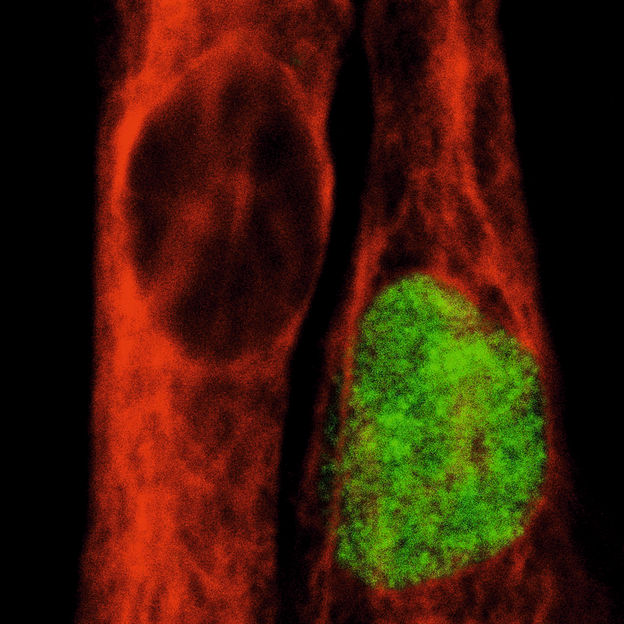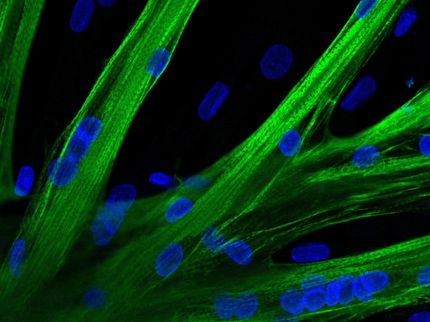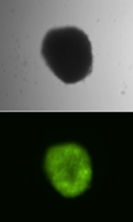New Research Method Opens Door to Therapy with Human Muscle Stem Cells
Promising Method Developed
Advertisement
stem cells are essential for the repair of muscle damage, but all attempts to manipulate human muscle stem cells for therapy have thus far failed. Now Dr. Andreas Marg and Prof. Simone Spuler of the Experimental and Clinical Research Center (ECRC), a joint cooperation between the Max Delbrück Center (MDC) and the Charité, have shown how this might work. They developed a method in which they did not isolate the muscle stem cells, but rather cultivated, proliferated and transplanted them along with their muscle fibers. Using this method in mice, they were able to successfully regenerate muscle tissue. Thus they have opened the door for the use of muscle stem cells to treat muscle diseases.

Muscle fiber fragment (red) with human muscle stem cells (green)
Photo: Andreas Marg/Copyright: ECRC
"Muscle stem cells, which we also refer to as satellite cells, can awaken in their stem cell niche after decades of quiescence and can then repair damaged muscle tissue," Professor Spuler explained. At the ECRC in Berlin-Buch, the neurologist heads the University Outpatient Clinic for Muscle Disorders and the Department of Muscle Sciences. She and her team are exploring the causes of muscle diseases. Evidence shows that satellite cells are active in people with severe muscle diseases such as Duchenne muscular dystrophy, a severe genetic disease in which the muscles degenerate. "But at some point,” she added, “the reservoir is depleted of muscle stem cells and muscle wasting cannot be stopped."
All attempts to rebuild muscle tissue by transplanting satellite cells in patients with Duchenne muscular dystrophy have failed. The transplanted cells are not viable. Furthermore, the use of other cells with potential to regenerate muscle cells has shown little success. These cells have only limited potential to regenerate muscle. But how is it possible to nevertheless use the body’s own self-renewal potential and the reconstruction potential of satellite cells?
The offer of developmental biologist Professor Carmen Birchmeier (MDC) to participate in the network project on satellite cells (SatNet) of the Federal Ministry of Education and Research pointed Professor Spuler and her co-workers in the right direction. One of the topics of the project was to elucidate why satellite cells rapidly lose their regeneration potential if they are kept in a cell culture. This led to the idea to cultivate the satellite cells together with the surrounding muscle tissue to see whether the cells, if they remain in their accustomed milieu, might possibly regenerate better.
Muscle biopsy specimens from young and old donors
After due approval and written, informed consent, Professor Spuler and Dr. Marg obtained specimens of fresh thigh muscle tissue from patients between 20 and 80 years of age from neurosurgeons of Helios Klinikum Berlin-Buch, which like the MDC is located close to the ECRC.
From the biopsy specimens, Professor Spuler and her co-workers dissected more than 1000 muscle fiber fragments, each about 2-3 millimeters long. Remarkably, the researchers found the number of stem cells in the individual tissue specimens to be independent of the age of the donor and that thousands of myoblasts developed from a small number of satellite cells. After further developmental steps, these fuse into muscle fibers.
Dr. Marg: “Satellite cells need to have their ‘local milieu’ around them”
Professor Spuler and her co-workers cultivated the muscle fiber fragments with the satellite cells, initially for up to three weeks. During this time, the satellite cells increased by 20- to 50-fold, but numerous connective tissue cells also developed in these cultures. To prevent this, the researchers concurrently subjected the muscle fragments to oxygen deprivation (hypoxia) and to cooling (hypothermia) at 4 degrees Celsius. Under these conditions, only satellite cells are able to survive in their stem cell niche, in contrast to the connective tissue cells. “Apparently, the satellite cells receive the proper nutrients in their own ‘local milieu’,” Dr. Marg said.
Human satellite cells cultivated and proliferated for the first time
For the first time, the ECRC researchers have succeeded in demonstrating that it is possible to cultivate and proliferate human satellite cells and to maintain their regeneration potential for several weeks. They have thus achieved an important prerequisite for using the patient’s own cells for therapeutic purposes.
First success in mice
The ECRC researchers then tried out their therapy approach in mice in which muscle regeneration had been inhibited by irradiation. They grafted the muscle fragments containing the satellite cells, which following the hypothermia had been kept for two weeks in culture dishes, into the tibalis anterior muscle. The researchers found that the muscles of animals that had been treated with these fiber fragments regenerated particularly well.
Objective: to couple satellite cells with gene therapy
However, a genetic muscle disease cannot be successfully treated alone by transplanting muscle fragments. Professor Spuler: “The idea is therefore to equip the satellite cells additionally with a healthy gene that repairs the defective gene and then to transfect it with the aid of a non-viral ‘gene taxi’ into the muscles to be treated. In a first experiment with a ‘reporter gene’ in the Petri dish, Professor Spuler and her co-workers proved that this is possible in principle. The reporter gene fluoresces green when it is transfected into the satellite cell. As gene taxi the researchers use the Sleeping Beauty transposon – a jumping gene that can change its position in the genome. This transposon technique was developed several years ago by Dr. Zsuzsanna Izsvák (MDC) and Dr. Zoltán Ivics (Paul Ehrlich Institute, Frankfurt) and is considered to be a very promising delivery vehicle (vector) for gene therapy.
Before the method developed by Professor Spuler and her group can be used to benefit patients, some hurdles remain to be taken. So far, the transplantation has succeeded in small mice muscles. In clinical trials, the scientists and physicians want to determine whether this technique can be used in large human thigh muscles, which may be severely altered due to a muscular disease.
Original publication
Other news from the department science
Most read news
More news from our other portals
See the theme worlds for related content
Topic world Gene therapy
Genetic diseases once considered untreatable are now at the center of innovative therapeutic approaches. Research and development of gene therapies in biotech and pharma aim to directly correct or replace defective or missing genes to combat disease at the molecular level. This revolutionary approach promises not only to treat symptoms, but to eliminate the cause of the disease itself.

Topic world Gene therapy
Genetic diseases once considered untreatable are now at the center of innovative therapeutic approaches. Research and development of gene therapies in biotech and pharma aim to directly correct or replace defective or missing genes to combat disease at the molecular level. This revolutionary approach promises not only to treat symptoms, but to eliminate the cause of the disease itself.
























































